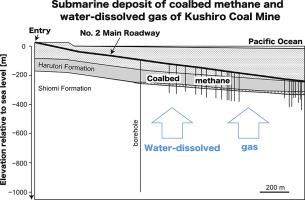当前位置:
X-MOL 学术
›
Int. J. Coal Geol.
›
论文详情
Our official English website, www.x-mol.net, welcomes your
feedback! (Note: you will need to create a separate account there.)
Formation of coalbed methane and water-dissolved gas in Kushiro Coal Mine, Japan, based on isotopic compositions of gas, groundwater, and calcite
International Journal of Coal Geology ( IF 5.6 ) Pub Date : 2020-09-01 , DOI: 10.1016/j.coal.2020.103577 Shuji Tamamura , Takuma Murakami , Akio Ueno , Satoshi Tamazawa , Tamotsu Kiyama , Hidenori Inomata , Hiroyuki Matsumoto , Kagemi Uchida , Yoshiaki Suzuki , Jun Aizawa , Katsuhiko Kaneko
International Journal of Coal Geology ( IF 5.6 ) Pub Date : 2020-09-01 , DOI: 10.1016/j.coal.2020.103577 Shuji Tamamura , Takuma Murakami , Akio Ueno , Satoshi Tamazawa , Tamotsu Kiyama , Hidenori Inomata , Hiroyuki Matsumoto , Kagemi Uchida , Yoshiaki Suzuki , Jun Aizawa , Katsuhiko Kaneko

|
Abstract Kushiro Coalfield is one of the largest coalfields in Japan, and Kushiro Coal Mine (KCM) is currently the only underground coal mine in the country. At KCM, coalbed methane (CBM) has been extracted from the Eocene Harutori Formation and water-dissolved gas from the Paleocene Shiomi Formation. This study investigates the origin of these gases and their formation environments. A positive correlation between δD(CH4) of the sampled gas and δD(H2O) of the groundwater, following δD(CH4) = δD(H2O) − 180 ± 20, indicates that CBM and water-dissolved gas in KCM are classified as secondary biogenic methane and were formed within in situ groundwater. The lower δ13C(CO2) values (less than −6.9‰) from KCM compared with representative CBM of biogenic origin from other coalfields imply the contribution of oxidants (e.g., SO42−) in the biodegradation of sedimentary organic matter (SOM) to CO2 in KCM. Conversely, high δ13C(CaCO3) values (>12.5‰) of calcite deposited in the coal seams of KCM imply negligible contributions of oxidants for SOM biodegradation when the calcite was formed. The methanogenic conditions at the time of calcite formation may have arisen when the rate of groundwater flow in the coal seams was higher than at present.
中文翻译:

基于瓦斯、地下水和方解石同位素组成的日本钏路煤矿煤层气和水溶气的形成
摘要 钏路煤田是日本最大的煤田之一,钏路煤矿(KCM)是日本目前唯一的地下煤矿。在 KCM,煤层气 (CBM) 已从始新世 Harutori 组和古新世 Shiomi 组的水溶气中提取。这项研究调查了这些气体的来源及其形成环境。采样气体的δD(CH4)与地下水的δD(H2O)呈正相关,遵循δD(CH4) = δD(H2O) − 180 ± 20,表明KCM中的煤层气和水溶气属于次要生物甲烷并在原位地下水中形成。与来自其他煤田的具有代表性的生物成因煤层气相比,来自 KCM 的较低的 δ13C(CO2) 值(小于 -6.9‰)意味着氧化剂的贡献(例如,SO42−) 在 KCM 中将沉积有机物 (SOM) 生物降解为 CO2。相反,沉积在 KCM 煤层中的方解石的高 δ13C(CaCO3) 值 (>12.5‰) 意味着当方解石形成时,氧化剂对 SOM 生物降解的贡献可以忽略不计。方解石形成时的产甲烷条件可能是由于煤层中地下水的流速高于现在。
更新日期:2020-09-01
中文翻译:

基于瓦斯、地下水和方解石同位素组成的日本钏路煤矿煤层气和水溶气的形成
摘要 钏路煤田是日本最大的煤田之一,钏路煤矿(KCM)是日本目前唯一的地下煤矿。在 KCM,煤层气 (CBM) 已从始新世 Harutori 组和古新世 Shiomi 组的水溶气中提取。这项研究调查了这些气体的来源及其形成环境。采样气体的δD(CH4)与地下水的δD(H2O)呈正相关,遵循δD(CH4) = δD(H2O) − 180 ± 20,表明KCM中的煤层气和水溶气属于次要生物甲烷并在原位地下水中形成。与来自其他煤田的具有代表性的生物成因煤层气相比,来自 KCM 的较低的 δ13C(CO2) 值(小于 -6.9‰)意味着氧化剂的贡献(例如,SO42−) 在 KCM 中将沉积有机物 (SOM) 生物降解为 CO2。相反,沉积在 KCM 煤层中的方解石的高 δ13C(CaCO3) 值 (>12.5‰) 意味着当方解石形成时,氧化剂对 SOM 生物降解的贡献可以忽略不计。方解石形成时的产甲烷条件可能是由于煤层中地下水的流速高于现在。











































 京公网安备 11010802027423号
京公网安备 11010802027423号